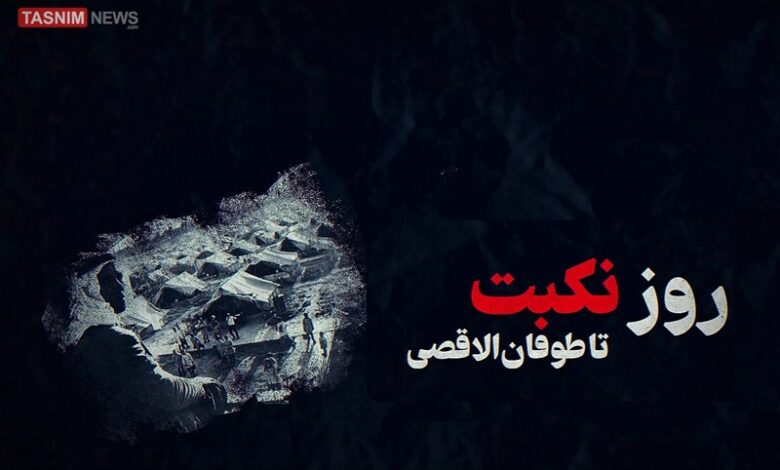Tasnim motion graphics From the day of Nakbat to the storm of Al-Aqsa

| Although the extensive destruction of the Gaza Strip is a direct result of the recent 7-month war, the fate of this strip is undoubtedly tied to the events of the Nakbat Day in 1948. |
According to the international group Tasnim news agency, Palestinians May 15, 1948 (May 25, 1327), which commemorates the occupation of 744 Palestinian towns and villages and the complete destruction of 530 of them, and at least 70 cases of killing and massacre of Palestinians by the terror squads of the Zionist regime, is remembered as “Nakbat Day”. . Due to the passage of time and the geographical distance of the Gaza Strip from the central areas of the occupied territories and the West Bank and the city of Jerusalem, it is somewhat difficult to imagine that Gaza was also heavily affected by the consequences of the Nakbat. The direct and indirect consequences of the Day of Nakbat for the Palestinians living in Gaza will be examined in the following. params=”{Aparat=mpg47y4}” href=”https://newsmediab.tasnimnews.com/Tasnim/Uploaded/Video/1403/03/05/140303051502505623015594″ rel=”nofollow” style=”display: block; width: 350px; height: 262px; margin: 0 auto 0 auto;”>.
Gaza strip Also, from the very beginning of the colonial life of the Zionist regime, it was heavily overshadowed by the manifestations of Israeli occupation. The displacement of a large number of Palestinians led to the formation of 8 refugee camps in the Gaza Strip between 1948 and 1949 despite the small area of this strip.
This is not the whole story of Israel’s occupation, and the Zionists have severely limited the natural right to life of Palestinians by applying various occupation policies. In the Six Day War of 1967, the Zionist regime added Jerusalem, the West Bank, the Gaza Strip, the Golan Heights and finally the Sinai Desert to its occupied territories. The occupation of the Gaza Strip and the West Bank continued in full until 1994 and only became less after the Oslo compromise.
From 1967 to 1985 , 13 Zionist towns and settlements were built in the Gaza Strip, the most important of which were Kafar Darum, Netsarim, Morag, Gosh Qatif and Netsar Hazani. The population of the Zionist settlements in 2004 (a year before Israel’s withdrawal from the Gaza Strip) had reached about 7 thousand people. This amount included almost one percent of the population of the Gaza Strip, but the Zionists had allocated 25% of the territory of Gaza to their settlements.
Sarah Roy writes in the book “Political Economy of the Dedevelopment of the Gaza Strip” that at the end of the Zionist presence in Gaza, each square mile of this strip was home to 2,000 Palestinians, but at the same time, there were 115 people in each mile of the Zionist settlements. has been present.
On the other side of the Zionist occupation, the destruction of the only airport in this strip was at the end of the Zionist presence in Gaza. Yasser Arafat’s government airport was established in 1998 in southern Gaza, but with the beginning of the second intifada in 2000, the Israelis bombed this airport and finally destroyed it completely in 2001.
As a result of Israel’s occupation policies, there was a greater social tendency to resist the Zionist regime in the Gaza Strip. Since the late 1980s, the resistance groups officially started their activities and within a few years they created a strong base in this group.
With forced exit Zionists from the Gaza Strip and the victory of Hamas in the 2006 Palestinian parliamentary elections, which led to the formation of a cabinet by this Palestinian group, the Israeli regime put the policy of embargo and blockade of Gaza on its agenda, and by applying the most severe colonial and security measures, the Gaza Strip was destroyed within a few days. Sal turned into the world’s largest open-air prison. Applying severe sanctions, closing 6 out of 7 crossings, violating economic and security agreements, and preventing the entry of humanitarian aid into this passage were included in the agenda of the Zionist regime since 2007. As a result of this siege, the food security in the Gaza Strip was seriously threatened and the unemployment of the young population increased to 50% within a few years. This siege has continued for the past 15 years and has been followed more intensively since the start of the recent war.
During the past 10 years, almost every We have witnessed a military attack by the Zionists on the Gaza Strip once every two years, and the Al-Aqsa storm is the first time that the Palestinians have taken the initiative to attack. As a result of these wars, more than 50 thousand Palestinians from Gaza have been martyred so far. obtained a new target to target this area and has carried out massive destruction and killing of civilians to avenge the defeat of October 7th in the last 7 months.
It is said that the amount of destruction in the Gaza Strip is such that 62% of the residential houses, that is, more than 290 thousand houses have been completely destroyed and more than one million people of the population of this strip have lost their homes. have given. Also, the World Bank recently announced that 18.5 billion dollars are needed for the reconstruction of this region. This figure is equal to 97% of the value of the gross domestic product of Palestine (including the West Bank and the Gaza Strip).
Some news indicate that the Zionist regime plans to establish four security zones in the Strip create Gaza and rebuild some former settlements in this strip. This brings a new level of Zionist occupation to the fore. In fact, it is clear that Nakba Day had many direct consequences for the lives of the people of Gaza.
end of message/
| © | Webangah News Hub has translated this news from the source of Tasnim News Agency |


